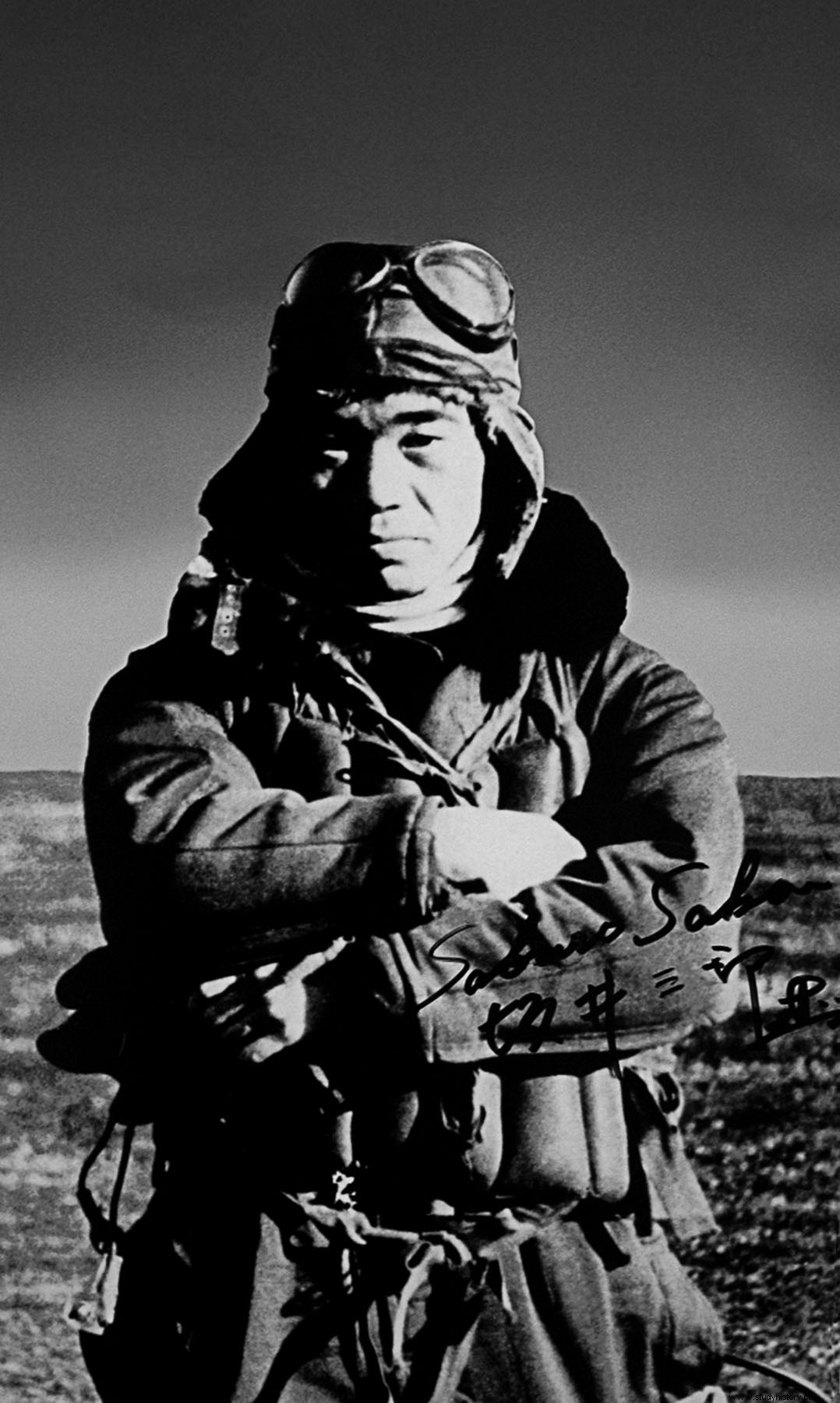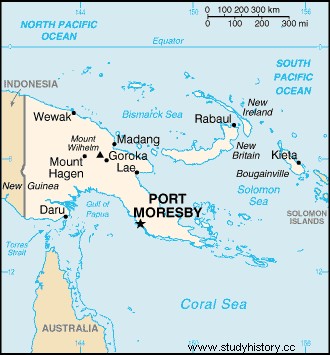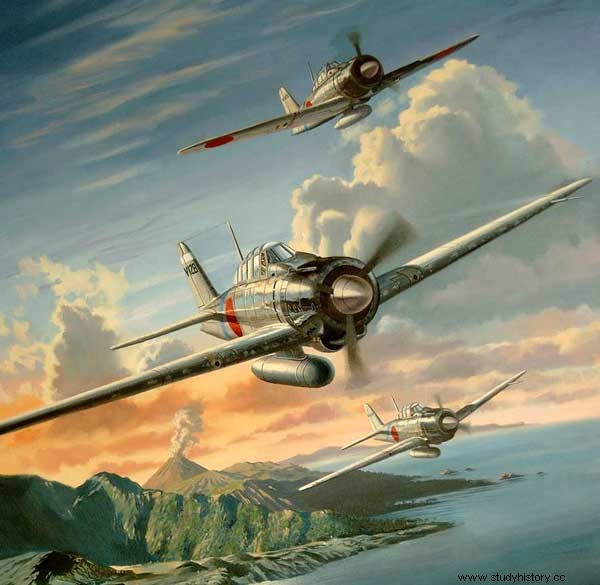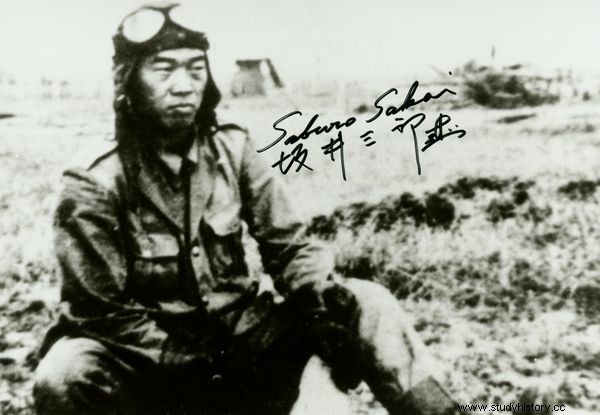World War II is a recurring theme among history buffs. But, although in the West we know by heart the deeds of the allied heroes (if in a war one can speak of heroic deeds), what happened on the opposite side is usually not as well known. In the German case perhaps this is not so pronounced. But if we go to the other great theater of war operations, the Pacific, few would know how to cite a protagonist of the Japanese army. Today we are going to try to give names and surnames to some of those men who fought on the losing side, whom history forgets so many times to the detriment of their American adversaries.
The little battle that we are going to tell is not really such, since not a single bullet was fired in it. Its protagonist is Saburo Sakai , one of the great aces of Japanese aviation during the war, and one of the few who managed to survive the conflict and reach old age. He died in 2000 at the respectable age of 84, while attending a fellowship meal with American veterans at which he was the guest of honor.

Saburo Sakai
Being stationed at the base of Lae atoll , in the Marshall Islands, Saburo Sakai he coincided with two other legendary figures of Japanese hunting: Hiroyoshi Nishizawa and Toshio Ota . The three hit it off and became a nightmare for the P-39 squads. American people. The «Cleaning Trio «, they were called, because every time they went out on a mission they left the perimeter completely clean of enemy planes. The year was 1942, when the Zero fighters they were still the lords of the South Pacific skies.
One day, the three friends were listening to music broadcasts on Australian radio in their bunkhouse. Between the metallic crackle of the loudspeaker they were able to distinguish the notes of the Danse Macabre , the famous «Dance of Death » by Camille Saint-Saëns. It is noteworthy that some soldiers of humble origin, coming from deep Japan at the beginning of the s. XX, were cultured enough to recognize a nineteenth-century symphonic poem as soon as they heard it. It is seen that the lyric knows how to impose itself no matter how bad the times are. Even on a lost atoll in the middle of the Pacific, in the middle of World War II. The music inspired the three boys, who were in their early 20s at the time, to get up to a little mischief. They decided to give the enemy a very particular Dance of Death, an aerial acrobatic courtesy of the «Cleaning Trio «. The occasion was not long in coming. The next morning it was time for a routine strafing mission on the allied base in Port Moresby , their usual enemies. The raid that day was not very fruitful for the Japanese:the Allied bombers, the main objective of the raid, were hidden. They were hardly able to cause any serious damage. Three squadrons of American P-39s went out to defend the airfield and, after a brief fight and the occasional shot down, they dispersed. The Zeros The Japanese did the same and, with the squad heading back to the base, Saburo Sakai he asked his commander's permission to move away from the formation, with the excuse of pursuing an enemy plane. His teammates Ota and Nishizawa took advantage of the situation and followed him too. But his intention was not to hunt any P-39 clueless They were going to do precisely what they had agreed to do the night before:dance their Dance of Death over Port Moresby .

According to Sakai in his autobiography, the three of them were not afraid to stand alone in the middle of the enemy sky. They were experienced pilots, between them they had almost 60 kills, and they relied on the speed and maneuverability of their Zero. to escape any trouble. But, strangely enough, the Americans did not seem to be in the mood to go out to meet them, perhaps impressed by the courage (or recklessness) of those three lonely pilots. Let Sakai tell us in his own words:
I was back over Port Moresby in a few minutes, circling over the airfield at 12,000 feet. The flak was silent and no enemy fighter appeared. Then two Zeros came up to me, and we got into formation with a few meters between the tips of our wings. Nishizawa and Ota smiled at me, and I waved my hand in greeting. I pushed back the cover of my cockpit, described a ring above my head with one finger, and then showed them three fingers. We had to do three curls, all three together.
One last look for enemy fighters and I lowered the bow to gain speed, with Nishizawa and Ota close to my plane. I pulled back on the control stick, and the Zero responded magnificently, climbing high and arching, turning on its back. The other two fighters followed with me and came up in a perfect inside loop. We went up two more times, dived, and corkscrewed again. Not a single cannon fired from below, and the sky remained clear of enemy planes. We could have been on our own airfield, judging by the excitement we seemed to provoke. I thought of all the men looking down on us and couldn't help but laugh out loud.

Dance of death
They also couldn't resist the temptation to repeat the stunt, this time much closer to danger, just 1,800 meters above the American airfield. Another three perfect ringlets, in identical synchronicity. An authentic aerial ballet over the very heads of the enemy. Not fully believing what they had done, and in order not to tempt fate too much, Sakai and his two companions headed for the base and landed in Lae , without major mishap, about twenty minutes after the rest of his squad. None of his superiors had realized what had happened. The perfect move, Sakai thought. Joining Ota and Nishizawa in the barracks, they burst out laughing. But the joy was short-lived. That same night, the lieutenant in charge summoned the three of them to an emergency meeting and, when they appeared before him, he received them with a grumpy scowl. They knew perfectly well that the stunt they had pulled over Port Moresby It was a recklessness of the fat ones, one of those that the severe ordinances of the Imperial Navy strictly prohibited. So now it was time for him to square off and endure the downpour. But how the hell had the lieutenant found out about that?
They didn't have to wonder long; he told her himself, releasing toads and snakes from his mouth. Minutes before, an enemy fighter had shown up at Lae solo and dropped a letter with a very special message:
To the attention of Commander Lae:
We were very impressed by those three pilots who visited us today, and we all really liked the corkscrews they did over our airfield. It was quite an exhibition. We'd appreciate it if the same pilots came back here tomorrow, each wearing a green scarf around their necks. We're sorry we didn't give you more attention on your last visit, but we'll make sure you get a great welcome next time.
Sincerely,
Port Moresby Fighter Squadron

Hearing that, Sakai and his comrades could barely contain their laughter. The lieutenant knew that he couldn't happily spare three of his best pilots, so he was very much spared arresting them. He sent them back to the barracks with a good scolding, and there it was. The next morning, the harsh reality of the war would set in again; the filigree and acrobatics would give way to the usual lead, fire and horror. Ota would fall in combat that same year, on Guadalcanal, and Nishizawa a little later, in 1944. They would not be lucky enough to grow old, like their comrade Sakai. But at least tonight they could be satisfied with his small victory. His Dance of Death had been a resounding success. A beautiful and poetic triumph that, moreover, had not required firing a single bullet. That they take away the bailao, never better said.
Collaboration of R. Ibarzabal , from Samurai Stories
Sources:Winged Samurai:Saburo Sakai and the Zero Fighter Pilots –Henry Sakaida; Samurai! – Saburo Sakai, Martin Caidin and Fred Saito
